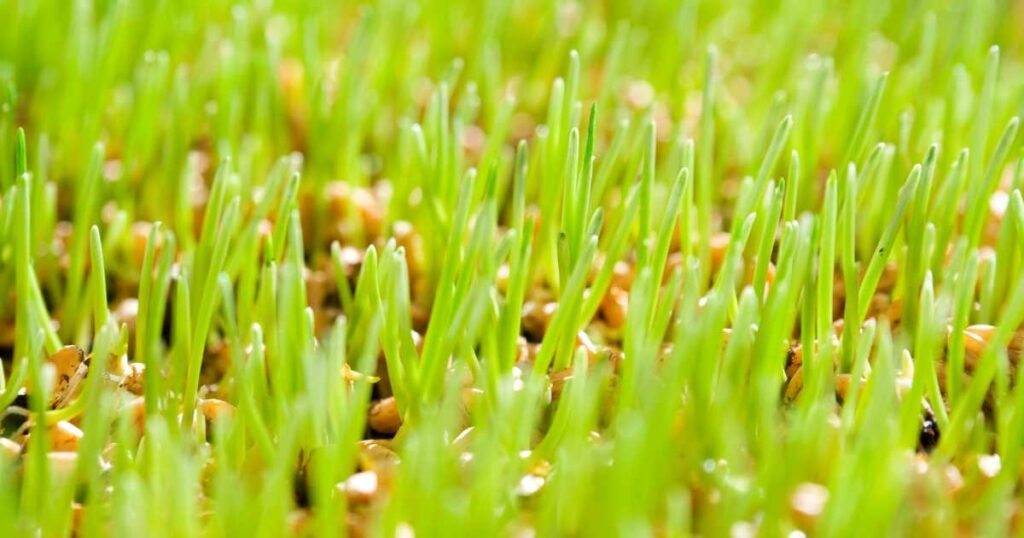
Introduction
Are you searching for how to grow wheatgrass at home? With its astounding health benefits, wheatgrass is quickly becoming a go-to for those seeking a greener diet. This blog will take you through the journey of cultivating wheatgrass indoors – from seed to harvest, offering practical tips along the way.
Are you ready to sprout some green magic? Let’s get started!
Key Takeaways
- Wheatgrass has numerous health benefits, including high nutritional value, detoxification properties, immune system support, and digestive health benefits.
- Growing wheatgrass at home is a simple process that can be done with or without soil. Providing optimal growing conditions such as proper lighting, watering schedule, temperature control, and humidity levels is crucial for successful growth.
- Soaking and germinating the organic wheatgrass seeds before planting them in a well-prepared container is essential for successful growth.
- Caring for the wheatgrass involves proper watering, misting to maintain humidity levels, and fertilising every one to two weeks.
- Promoting growth involves keeping the planted seeds in a dark place for 2 – 3 days to encourage germination and then moving them into indirect sunlight once sprouts emerge.
Benefits of Wheatgrass
Wheatgrass offers a wealth of benefits due to its high nutritional value and detoxification properties
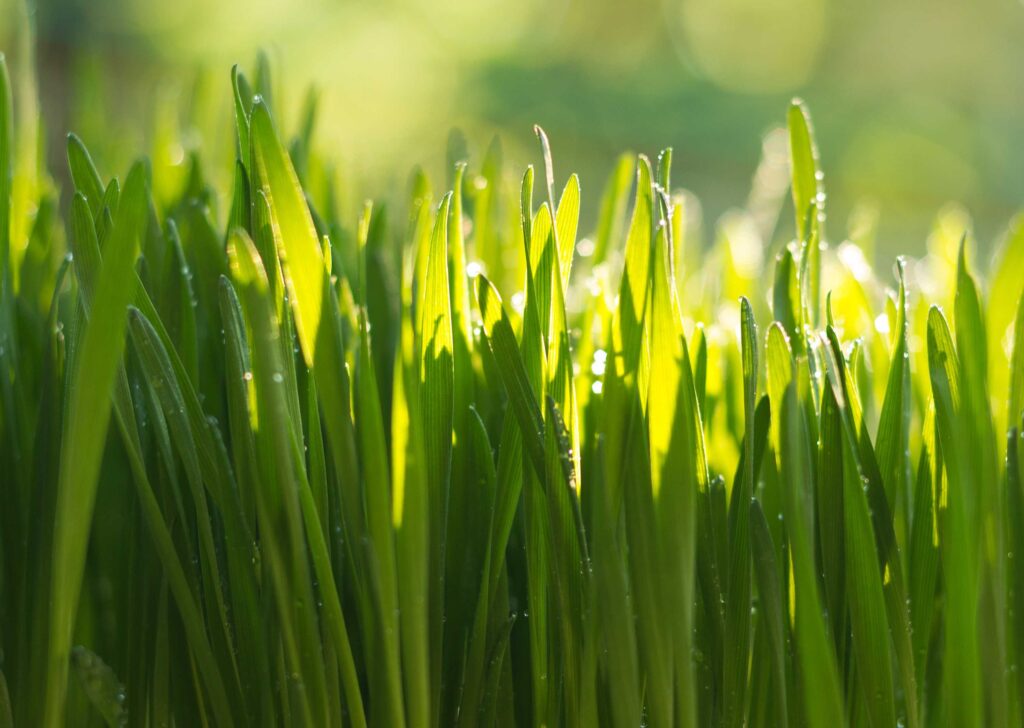
Nutritional value
Packed with an impressive array of nutrients, wheatgrass is a veritable powerhouse of health. It brims with essential vitamins such as A, B6, C, E and K, all vital for optimal body function.
It is rich in vitamins and boasts minerals like iron, zinc manganese and selenium to name just a few. What’s more? This green wonder contains potassium – an important nutrient that supports heart health among other benefits.
So growing your wheatgrass allows you access to this fresh addition for smoothies or juices and ensures a constant supply of these valuable nutrients right at home.
Detoxification properties
Wheatgrass packs a potent punch in the detoxification department. Its chlorophyll-rich content aids in purifying the liver, a key organ for eliminating toxins from your body. Wheatgrass consumption can trigger an upsurge in enzyme activity that bolsters the body’s defence against harmful substances.
Moreover, wheatgrass has shown positive impacts on blood purification and circulation. It helps oxygenate blood thereby promoting overall vitality and wellness. So, incorporating homemade wheatgrass into your diet might be just what you need to turbocharge your detox routine! Experience the invigorating benefits of indoor wheatgrass cultivation today!
Immune system support
Packed with a potent blend of vitamins, minerals and antioxidants, wheatgrass is an ally in bolstering your immune system. Notably, it boasts high concentrations of vitamins A and C, both renowned for their immunity-boosting properties.
On top of that, it’s abundant in selenium which plays a pivotal role in enhancing the immune response. Consuming wheatgrass juice or integrating it into your diet can therefore fortify your body’s defences against common illnesses and infections all year round.
Growing wheatgrass indoors ensures you have a fresh supply to reap its health benefits including improved digestion and detoxification – further strengthening the body’s natural defence mechanisms.
Organic wheatgrass seeds are ideal for home cultivation as they provide superior germ-free growth without any harmful pesticides that could compromise these health benefits.
Digestive health benefits
Wheatgrass offers numerous digestive health benefits. Packed with essential nutrients and enzymes, it aids in digestion by promoting the natural breakdown of food and preventing digestive disorders.
The high fibre content in wheatgrass helps regulate bowel movements and prevent constipation, while also supporting a healthy gut microbiome. Additionally, wheatgrass contains chlorophyll, which has been shown to help cleanse the digestive system by removing toxins and supporting liver function.
Regular consumption of wheatgrass can improve overall digestion and promote a healthier gastrointestinal tract.
Growing Wheatgrass at Home

Growing wheatgrass at home is a simple and rewarding process that can provide you with a constant supply of this nutritious plant.
Choosing a growing method (with soil or without soil)
When it comes to growing wheatgrass, you have the option of choosing a growing method with soil or without soil. Growing with soil is the traditional approach and provides a more stable environment for the seeds to sprout and develop.
It allows for easier nutrient absorption and creates a better root system. To grow wheatgrass with soil, you will need organic wheatgrass seeds, high-quality potting soil, and trays or pots.
On the other hand, if you prefer a cleaner and hassle-free method, growing wheatgrass without soil is also possible. This technique involves using water as the medium instead of soil. Organic wheatgrass seeds are soaked in water until they germinate before being transferred to special trays or containers designed for hydroponic cultivation.
Selecting the right seeds (organic wheatgrass seeds)
To ensure successful wheatgrass cultivation, it is crucial to select the right seeds, preferably organic wheatgrass seeds. Organic seeds are free from harmful pesticides and chemicals that could potentially affect the nutritional value of the wheatgrass.
These high-quality seeds are also more likely to have a higher germination rate, ensuring a healthier yield. When choosing your organic wheatgrass seeds, make sure they are specifically labelled for sprouting or microgreen purposes to ensure optimal growth.
By selecting the right seeds, you can lay the foundation for growing vibrant and nutrient-rich wheatgrass at home.
Preparing the growing container (tray or pot)
To successfully grow wheatgrass at home, it’s essential to choose the right growing container. You have two options: a tray or a pot. A tray is ideal for larger quantities of wheatgrass, while a pot works well if you have limited space or want to grow just a small amount.
Make sure whichever option you choose has adequate drainage holes to prevent waterlogging. Additionally, consider the size of the container based on the desired quantity of wheatgrass. Remember, having enough space allows for proper root growth and reduces the risk of overcrowding, which can lead to mould or fungus issues.
By selecting an appropriate growing container, you’ll provide your wheatgrass with an optimal environment for healthy growth and development.
Providing the ideal growing conditions (light, water, temperature, humidity)
To ensure successful growth, wheatgrass requires specific growing conditions. When it comes to light, wheatgrass thrives in bright indirect sunlight or artificial light. Place the growing container near a south-facing window or use fluorescent grow lights for around 12-16 hours per day.
Adequate lighting will promote healthy and vibrant growth.
In terms of water, wheatgrass needs consistent moisture but not excessive watering. Keep the soil evenly moist by misting it with a spray bottle or using a watering can with a fine nozzle. Avoid overwatering as it may lead to mould or fungus growth.
Maintaining an optimal temperature is crucial for wheatgrass cultivation. Aim for a temperature range between 60 and 70 degrees Fahrenheit (15-21 degrees Celsius) during the day and slightly cooler at night.
This temperature range provides the ideal conditions for germination and steady growth.
Humidity plays a role in creating favourable conditions as well. Wheatgrass prefers higher humidity levels than what is typically found indoors, so you can increase humidity by placing trays of water nearby or using a room humidifier.
However, avoid excessive humidity that can cause mould issues.
Step-by-Step Guide to Growing Wheatgrass
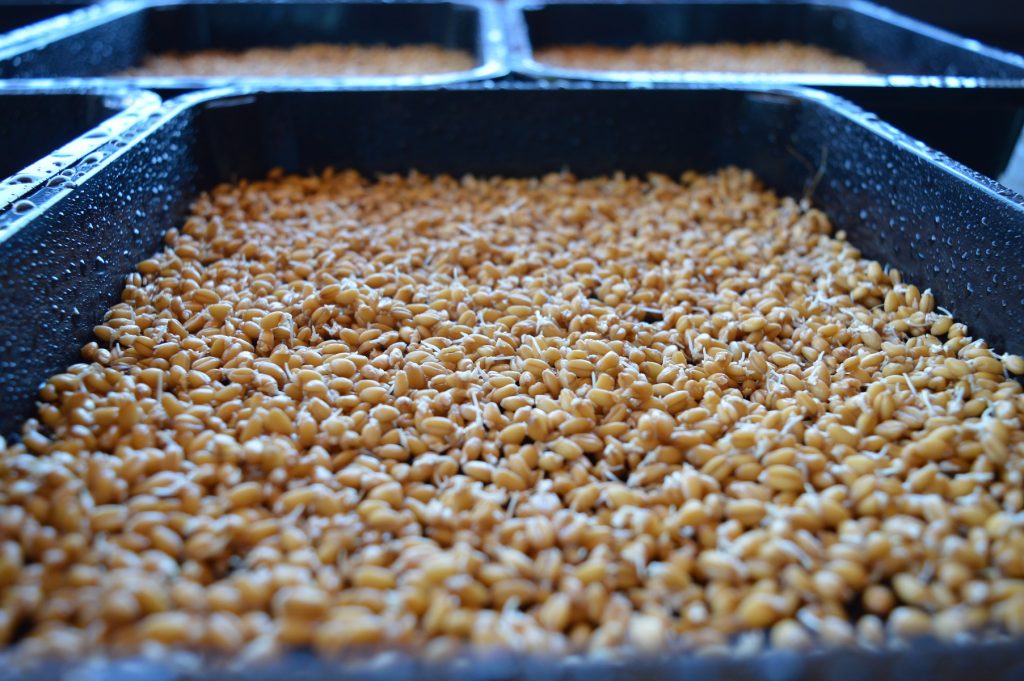
1. Soaking and germinating wheatgrass seeds
To ensure successful wheatgrass growth, it’s important to properly soak and germinate the seeds. Start by soaking the organic wheatgrass seeds in water for about 12 hours. This process helps to soften the outer shell of the seed and kickstart the germination process.
After soaking, make sure to drain and rinse the seeds thoroughly before planting them. By following these simple steps, you’ll be on your way to growing vibrant and healthy wheatgrass in no time.
So go ahead and get started with this essential part of cultivating your wheatgrass at home!
2. Planting the seeds in the growing container
To plant the seeds in the growing container, first, make sure you have chosen a tray or pot that is deep enough to support the growth of wheatgrass. Fill it with quality soil or a suitable growing medium, leaving about an inch of space at the top.
Next, evenly spread out the organic wheatgrass seeds on top of the soil. Gently press them into the soil without burying them too deeply.
Remember to leave some space between each seed to allow room for growth. After planting, water the seeds thoroughly but gently using a misting spray bottle or a watering can with a fine spray nozzle.
Avoid overwatering as it can cause mould or fungus growth.
Now that your wheatgrass seeds are planted and properly watered, place your growing container in an area with indirect sunlight or under grow lights specifically designed for plants. Keep in mind that excessive heat may hinder germination and stifle growth.
Monitor your seedlings daily and ensure they receive adequate moisture by lightly misting them once or twice throughout the day. Be patient as it takes approximately 7 days for wheatgrass to grow from seeds.
3. Caring for the wheatgrass (watering, misting, fertilising)
To ensure healthy growth, caring for your wheatgrass involves proper watering, misting, and fertilising. Water your wheatgrass daily to keep the soil evenly moist but not waterlogged. Avoid overwatering as it can lead to fungal diseases.
A good rule of thumb is to water when the top ½ inch of soil feels dry.
Misting your wheatgrass once or twice a day helps maintain the necessary humidity levels and prevents the leaves from drying out. Use a spray bottle filled with filtered water to lightly mist the grass without soaking it.
Fertilise your wheatgrass every one to two weeks with an organic liquid fertiliser diluted in water. This provides essential nutrients for its growth and overall health. Be sure to follow the instructions on the fertiliser package for proper dilution ratios.
4. Promoting growth (keeping in the dark, moving to sunlight)
To promote the growth of your wheatgrass, it’s important to create the right environment at different stages. After planting the seeds in your growing container and covering them with a thin layer of soil, keep them in a dark place for about 2-3 days.
This will encourage the seeds to germinate without exposure to light.
Once you start seeing sprouts emerging, it’s time to move your wheatgrass into the sunlight. Find a sunny spot near a window where it can receive indirect sunlight for most of the day. Direct sunlight can scorch young wheatgrass, so make sure to avoid placing it under harsh rays.
During this stage, continue watering your wheatgrass regularly and misting it occasionally throughout the day to maintain optimal humidity levels.
5. Harvesting the wheatgrass at the optimal time
Harvesting wheatgrass at the right time is crucial to ensure its maximum nutritional potency. Typically, you should harvest when the wheatgrass reaches a height of around 6-8 inches or has fully developed two leaves on each blade.
This stage usually occurs after 7-10 days of growth from planting the seeds.
To harvest, simply use sharp scissors or a clean knife to cut the wheatgrass just above the soil level. Be careful not to pull it out from the roots as this can damage future growth.
Tips for Successful Wheatgrass Growth
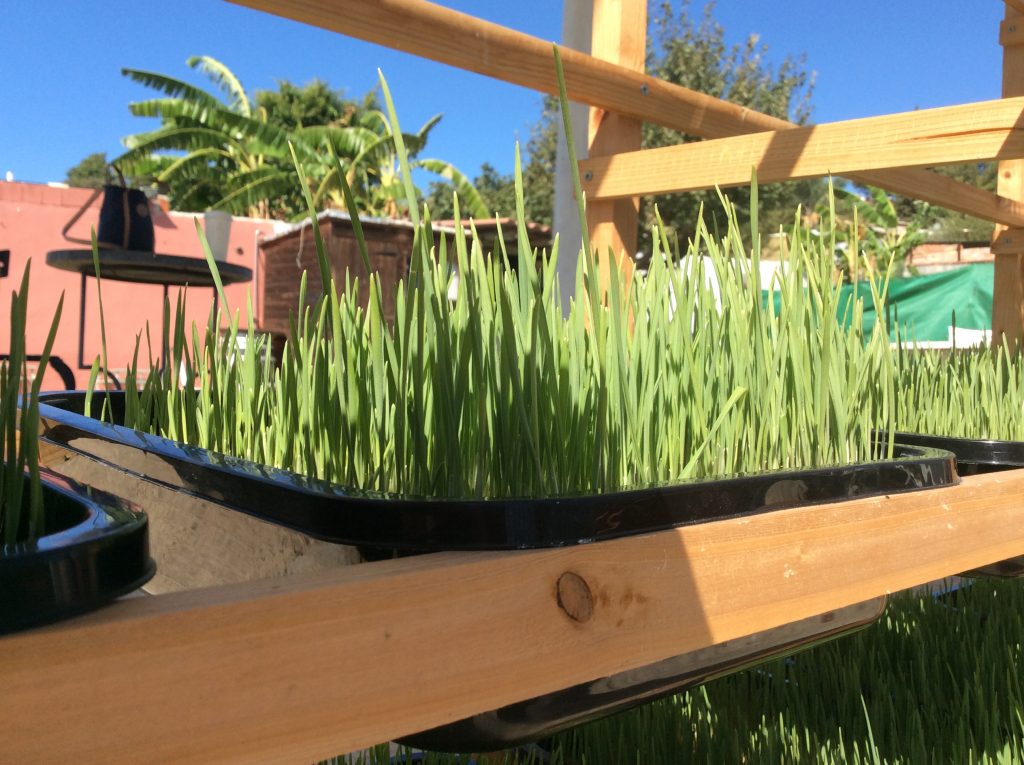
Keeping the growing area clean and free from pests
Maintaining a clean and pest-free growing area is crucial for successful wheatgrass cultivation. Pests can damage plants, introduce diseases, and hinder their growth. Regularly inspect the growing containers and surrounding areas for any signs of pests like insects or rodents.
Cleanliness is essential in preventing infestations, so make sure to remove any dead leaves or debris from the trays or pots. Additionally, keep the growing area well-ventilated and avoid over-watering as excessive moisture can attract pests.
By diligently maintaining a clean environment, you can ensure healthy growth for your wheatgrass crop.
Using quality soil or growing medium
To ensure successful wheatgrass growth, it is important to use quality soil or a suitable growing medium. The soil should be rich in nutrients and free from any contaminants that could hinder the plant’s development.
Opting for organic potting soil or compost can provide the necessary nutrients for healthy wheatgrass growth.
If you prefer a soilless growing method, there are alternative mediums available such as coconut coir, vermiculite, or peat moss. These mediums offer excellent water retention properties while providing adequate drainage to prevent waterlogged roots.
Regularly monitoring and adjusting growing conditions
To ensure successful wheatgrass growth, it is crucial to regularly monitor and adjust the growing conditions. Pay close attention to factors such as light, water, temperature, and humidity levels.
Wheatgrass requires around 12-16 hours of indirect sunlight each day for optimal growth. If you notice that your wheatgrass is not receiving enough light or is becoming leggy, consider moving it closer to a window or using artificial grow lights.
Watering is another important aspect of caring for wheatgrass. Keep the soil moist but be careful not to overwater as this can lead to mould or fungal growth. Monitor the moisture level by touching the soil with your finger; if it feels dry about an inch below the surface, then it’s time to water again.
Temperature also plays a significant role in wheatgrass cultivation. The ideal temperature range for sprouting wheatgrass seeds is between 60-70 degrees Fahrenheit (15-21 degrees Celsius). If the temperature fluctuates too much outside these parameters, it can affect germination and overall growth.
Lastly, maintaining proper humidity levels is essential for healthy wheatgrass. Aim for a relative humidity level of around 40-50%. You can use a hygrometer or simply observe any signs of wilting or drying out in your plants as indicators of inadequate humidity.
How to Use Wheatgrass
Once you have successfully grown your wheatgrass, there are several ways you can incorporate it into your daily routine. From juicing to adding it to smoothies or using it as a dietary supplement, the possibilities are endless.
Discover how to reap the maximum benefits of wheatgrass and explore creative ways to incorporate this nutrient-rich superfood into your lifestyle. Learn more here: [link].
Juicing the wheatgrass
To reap the full benefits of wheatgrass, juicing is a popular and convenient way to consume this nutritious plant. Once your wheatgrass has reached its optimal height of 7-10 inches, it’s time to juice it.
Start by cutting the stalks just above the soil level using sharp scissors or a knife. Rinse the freshly cut wheatgrass thoroughly to remove any dirt or debris.
Next, gather a handful of wheatgrass and pass it through a juicer. You can use either a manual juicer or an electric one, depending on your preference and availability. Ensure that you are collecting the juice in a clean container.
Once you have extracted all the juice from your harvested batch of wheatgrass, pour it into an airtight glass bottle or jar for storage. It’s best consumed immediately after juicing to retain maximum freshness and nutritional value.
Remember, when consuming wheatgrass juice for the first time, start with small amounts (around one ounce) and gradually increase as tolerated. Some individuals may experience detoxification symptoms initially due to its powerful cleansing properties.
Incorporating wheatgrass into smoothies or other recipes
Wheatgrass is a versatile and nutritious ingredient that can be easily incorporated into smoothies or other recipes, adding a vibrant dose of health benefits. To make a wheatgrass smoothie, simply blend fresh wheatgrass with your favourite fruits, vegetables, and liquid base like coconut water or almond milk.
You can also add in some ice cubes for a refreshing twist.
For other recipes, consider adding wheatgrass to homemade juices, salad dressings, or even energy bars. The rich vitamins and minerals found in wheatgrass will give your dishes an instant nutritional boost.
Be mindful of the strong taste of wheatgrass – it has a slightly bitter and earthy flavour. Start with small amounts and gradually increase as you adjust to the taste.
Remember to follow proper harvesting techniques when using wheatgrass in recipes. Harvesting at the right time ensures maximum nutrient content without compromising quality. Whether you choose to juice it or mix it into dishes, incorporating wheatgrass into your diet is an easy way to reap its numerous health benefits while enjoying delicious meals.
Using wheatgrass as a dietary supplement
Wheatgrass can be a convenient and easy way to incorporate essential nutrients into your diet. As a dietary supplement, wheatgrass offers numerous health benefits due to its high nutritional content.
Packed with vitamins A, B6, C, E, and K, as well as minerals like potassium and iron, wheatgrass provides a natural boost for your immune system and overall well-being. Adding wheatgrass powder or juice to your daily routine is simple – you can mix it into smoothies or other recipes to enhance the nutritional value of your meals.
Just remember to consult with a healthcare professional before incorporating wheatgrass into your diet if you have any underlying health conditions or concerns. With its impressive array of vitamins and minerals, using wheatgrass as a dietary supplement is an excellent way to optimise your nutrition easily.
Safety Precautions and Considerations
When growing wheatgrass, it is important to prioritise safety and consider a few precautions. Firstly, always choose organic seeds to avoid exposure to harmful pesticides or chemicals. Secondly, ensure that the growing equipment is properly cleaned and sterilised before use to prevent any contamination.
Lastly, consult with a healthcare professional before consuming wheatgrass, especially if you have any existing medical conditions or are taking medications. Stay safe while enjoying the numerous benefits of this wonderful plant!
Choosing organic seeds and avoiding pesticides
To ensure the healthiest and most nutritious wheatgrass, it is important to choose organic seeds and avoid pesticides. Organic seeds are free from any genetically modified organisms (GMOs) or chemical treatments, making them a safer option for cultivation.
Pesticides, on the other hand, can not only compromise the quality of your wheatgrass but also introduce harmful toxins into your body when consumed. By opting for organic seeds and avoiding pesticides during the growing process, you can rest assured that you are providing yourself with a pure and wholesome source of nutrients.
Properly cleaning and sterilising the growing equipment
To ensure successful wheatgrass growth, it is essential to properly clean and sterilise your growing equipment. This helps prevent the growth of harmful bacteria or mould that can negatively impact the wheatgrass.
Before you begin planting new seeds, thoroughly wash all trays, pots, or containers with warm soapy water. Rinse them well to remove any soap residue.
After cleaning, sterilise the equipment using a diluted bleach solution or hydrogen peroxide. Mix one part bleach or hydrogen peroxide with nine parts water and use this mixture to wipe down all surfaces of the containers and trays.
Let them air dry completely before proceeding with planting.
Consulting a healthcare professional before consuming wheatgrass
It is important to consult a healthcare professional before consuming wheatgrass, especially if you have any underlying health conditions or are taking medication. While wheatgrass is generally considered safe for most people, it can interact with certain medications and may not be suitable for everyone.
A healthcare professional can assess your health situation and guide whether incorporating wheatgrass into your diet is appropriate for you. They can also advise on the recommended dosage and potential side effects to watch out for.
Prioritizing your safety and well-being by seeking professional advice will ensure that you can enjoy the benefits of wheatgrass without any potential risks.
Troubleshooting Common Wheatgrass Growing Issues
If you notice mould or fungus growth on your wheatgrass, remove the affected plants immediately and make sure to keep the growing area clean and free from excess moisture.
Mould or fungus growth
Mould or fungus growth is a common issue that wheatgrass growers may encounter during the cultivation process. It can be caused by excess moisture and poor air circulation, as well as improper cleaning of the growing equipment.
To prevent mould or fungus from developing on your wheatgrass, it is crucial to keep the growing area clean and free from any debris. Regularly sterilising your growing containers and equipment will also help eliminate any potential sources of contamination.
Additionally, ensuring proper ventilation and avoiding over-watering can help minimise the risk of mould or fungus growth. Taking these precautions will ensure that your wheatgrass grows healthy and free from any unwanted fungal infestation.
Seedling failure
Unfortunately, seedling failure can occur during the process of growing wheatgrass. This can be quite frustrating, especially if you’re eager to enjoy the benefits of fresh wheatgrass. One common reason for seedling failure is poor seed quality.
If your seeds are old or damaged, they may not germinate properly. That’s why it’s important to ensure that you’re using fresh and organic wheatgrass seeds.
Another factor that can contribute to seedling failure is overwatering or underwatering. Wheatgrass needs just the right amount of moisture to thrive, so it’s crucial to strike the appropriate balance.
Additionally, insufficient light or incorrect temperature conditions could hinder successful sprouting and growth.
Yellowing or wilting of the wheatgrass
One common issue that wheatgrass growers may encounter is the yellowing or wilting of the wheatgrass. This can be a sign of nutrient deficiency, insufficient watering, or poor growing conditions.
To prevent this problem, it’s important to monitor and adjust the growing conditions accordingly. Ensure that the wheatgrass receives adequate sunlight exposure and water it appropriately to maintain proper hydration.
Additionally, using quality soil or a suitable growing medium can provide the necessary nutrients for healthy growth. Regularly monitoring and addressing any issues promptly will help ensure vibrant and thriving wheatgrass plants.
Frequently Asked Questions about Growing Wheatgrass
Growing wheatgrass at home can raise several questions, particularly for beginners. Here are some frequently asked queries:
1. Why should you use organic wheatgrass seeds for indoor planting? Organic seeds are free from pesticides or harmful chemicals, making them safe for consumption.
2. What is the ideal temperature for wheatgrass sprouting? The optimum temperature for wheatgrass sprouting is around 60-70 degrees Fahrenheit.
3. How long should wheatgrass seeds be soaked before planting? Wheatgrass seeds need to be soaked for about 12 hours before planting.
4. Can wheatgrass be grown without soil? Yes, wheatgrass can also be grown without soil using just organic wheatgrass seeds and water.
5. How long does it take for wheatgrass to grow from seeds? It takes approximately seven days for wheatgrass to grow from seeds.
6. Is it possible to grow wheatgrass outdoors? While wheatgrass can be grown outdoors, growing it indoors ensures a steady supply and control over the growing conditions.
7. How often should a new batch of wheatgrass be planted? By rotating three or four containers and planting a new one every four to five days, you will always have fresh wheatgrass.
8. What nutritional value does wheatgrass carry? Wheatgrass is a rich source of vitamins, including A, B6, C, E, and K, as well as minerals such as iron, zinc, manganese, selenium, and potassium.
9. How to use wheatgrass once it’s grown? The freshly harvested wheatgrass can be juiced or incorporated into smoothies or other recipes as a dietary supplement.
Conclusion
In conclusion, growing wheatgrass at home is a simple and rewarding process. By following the step-by-step guide outlined in this article, you can enjoy the numerous benefits of this nutritious plant.
Whether you choose to grow it with soil or without, indoors or outdoors, incorporating wheatgrass into your daily routine can be a valuable addition to your overall health and well-being. So why wait? Start growing your own wheatgrass today and experience its amazing advantages firsthand!
FAQs
1. What are the ideal growing conditions for wheatgrass?
Wheatgrass thrives in cool temperatures between 60°F and 75°F (15°C to 24°C) with indirect sunlight. It prefers a well-draining soil that is slightly acidic.
2. How often should I water my wheatgrass?
It is important to keep the soil evenly moist but not waterlogged. Water your wheatgrass once or twice a day, making sure not to overwater as it can lead to root rot.
3. When is the best time to harvest wheatgrass?
Wheatgrass is typically ready for harvest around 7-10 days after planting when it reaches a height of about 6-8 inches (15-20 cm). Harvesting at this stage ensures optimal nutrient content.
4. Can I reuse the soil after harvesting wheatgrass?
While you can reuse the soil, it’s recommended to refresh it by adding compost or organic matter before replanting. This helps replenish nutrients and maintain optimal growing conditions for future crops of wheatgrass.
Contact Warren Adams from Warrens Wheatgrass
if you want to learn how to grow wheatgrass - warren@warrenswheatgrass.com or call, whatsapp or send a text to +44 7904 531864
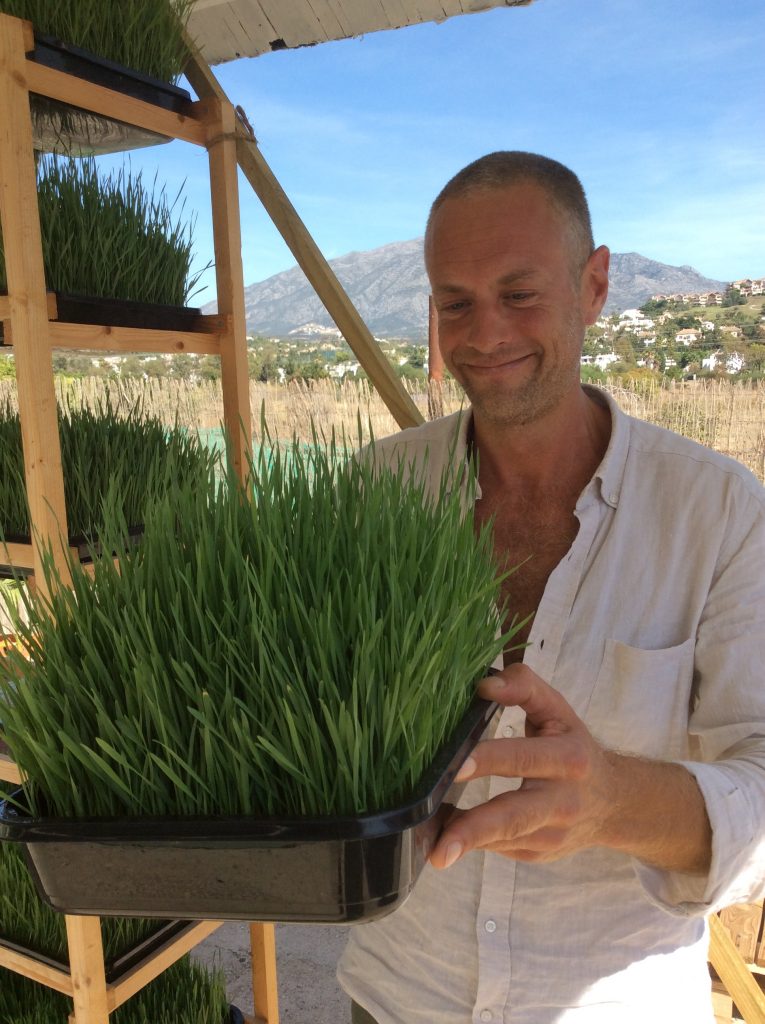
Hi, I’m Warren. I grow wheatgrass full time every day. Wheatgrass actually saved my life and I have spend the last 10 years perfecting the growth to optimize everything. If you want to grow the best possible wheatgrass, I’m here to help you. Please don’t hesitate to contact me by mail warren@warrenswheatgrass.com or call, whatsapp or send a text to +44 7904531864